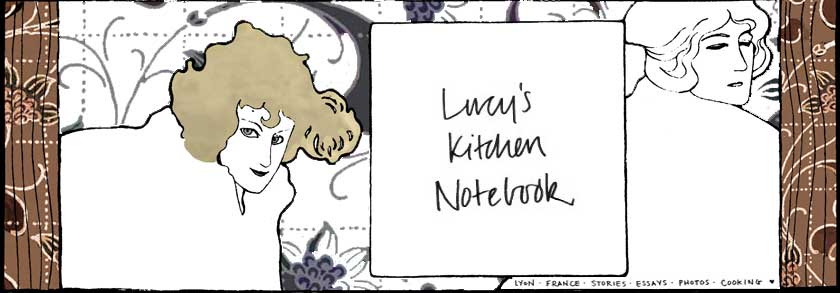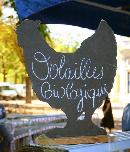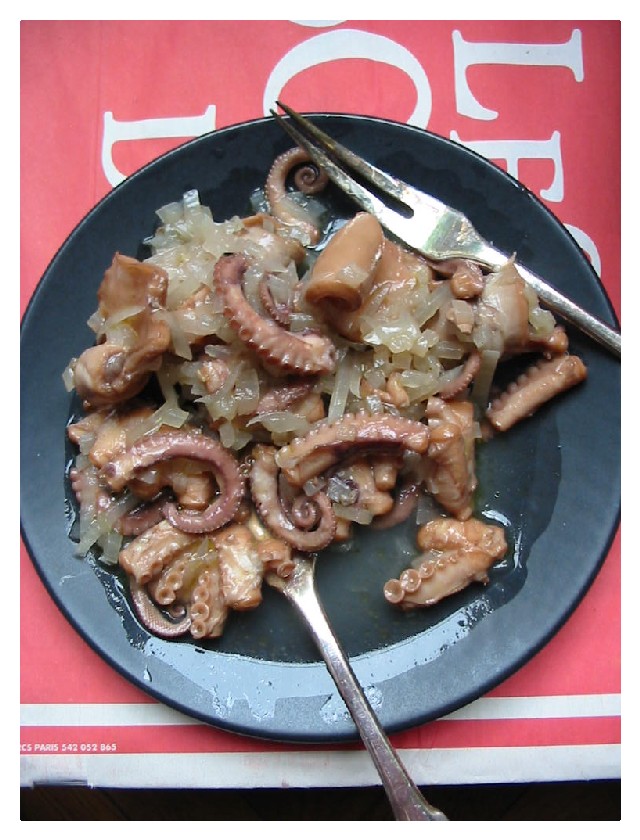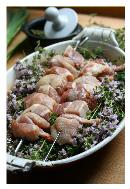Figatellu / Figatelli
 Brigitte is fond of Corsican meat products, and has introduced us to many different types of sausage and smoked meats, one here, one there, each time we visit. This weekend we traveled down to the Cote d'Azur and sure enough on her terrace we were served a new one.
Brigitte is fond of Corsican meat products, and has introduced us to many different types of sausage and smoked meats, one here, one there, each time we visit. This weekend we traveled down to the Cote d'Azur and sure enough on her terrace we were served a new one. The name of this Corsican sausage comes from the Italian fegato, meaning liver. Liver is the central element, and it is lightly smoked. This past weekend, we enjoyed the dried sausages with aperitif before Sunday dinner. We had a couple of fickle eaters who wrinkled their nose at the idea of figatelli since pork blood plays a role in giving it a dark color and rich taste. Of course we were delighted, because it meant more for us!
The Corsicans are really good at acheiving that fine balance between the flavor of the meat and smoke. The dried sausage was not intensely smoke flavored. Loic began to peel the casing off the sausage like paper because the drying process had made it quite hard. Chewing it was difficult. Someone at the table said he enjoyed to heat up fresh figatelli sausage and serve it on toast.
During our drive back home, Loic took a wrong turn and we found ourselves winding up a mountain road we'd never been on before. The road continued on and on but we were not concerned, we had all day to get home. The view was beautiful, and we barely saw a soul. I had one of those feelings, and told Loic that when we reached the top of the mountain, there would be a cheap restaurant with great food. He laughed out loud and told me that we would most likely not even find a town. Sure enough, just after reaching the top of the mountain, we reached a town. There was a bustling roadside cafe/bar/tabac that I knew was going to be good when I caught sight of the wood pile and outdoor fireplace. Strangely enough, we glided into a parking spot that seemed as if it was made for us, and arrived just in time to get the last table on the terrace. The clientele was a mix of locals that circulated among the tables and talked to one another, and people like us passing through. We enjoyed our lunch in the sun.
Since it was on the menu and fresh in our minds, Loic ordered the fresh Figatellu for the first time. What he was served looked a bit like boudin noir, but was strongly flavored with garlic and wine, completely different from little dried sausages we had the day before. One more thing to add to the list of things to try at least a few times to come to a real understanding of this sausage and its possibilities.
To make Figatelli at home:
Take one part each of fresh ham, pork liver, and pork fat and chop them finely. Season with 2 teaspoons of salt, 2 teaspoons of ground black pepper, and 2 ground cloves (about 1/4 teaspoon) per pound. Let sit overnight in a cool dry place. In the morning, crush 2 cloves of garlic per pound of meat, and put the garlic into a strainer - pour about 2/3 cup per pound quality red or rose wine over the garlic into the meat so that the wine takes the flavor of the garlic. Adding wine will reduce the shelf life of the sausage, but adds an interesting depth of flavor. If you plan to dry the sausage, don't add the wine. Stuff your sausage casings with the mixture and smoke the sausages. Place it in a cool dry dark place to rest. It can be eaten fresh, grilled or braised and serve with polenta or potatoes, or dried, to be eaten as an aperetif snack.
Labels: Cured Meat and Sausages, Spring 06, Summer





















































3 Comments:
Given that I want to experience as much in this life as possible....I will, within reason (read no live bugs or fear factor nonsense) try pretty much anything these days! :) Fickle eater I am not!! lol
Really - anyone who would wrinkle up their nose at anything should be given a pinch.
Maybe even a hard pinch.
I agree with doggerelblogger. Especially when it happens when being served at someone else's home. What an extreme lack of gratitude in return for well-meaning, warm hospitality. Tsk. Tsk.
Post a Comment
<< Home